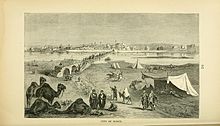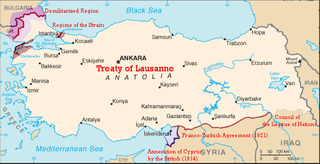
The Treaty of Lausanne is a peace treaty negotiated during the Lausanne Conference of 1922–23 and signed in the Palais de Rumine in Lausanne, Switzerland, on 24 July 1923. The treaty officially resolved the conflict that had initially arisen between the Ottoman Empire and the Allied French Republic, British Empire, Kingdom of Italy, Empire of Japan, Kingdom of Greece, Kingdom of Serbia, and the Kingdom of Romania since the outset of World War I. The original text of the treaty is in French. It emerged as a second attempt at peace after the failed and unratified Treaty of Sèvres, which had sought to partition Ottoman territories. The earlier treaty, signed in 1920, was later rejected by the Turkish National Movement which actively opposed its terms. As a result of the Greco-Turkish War, İzmir was reclaimed, and the Armistice of Mudanya was signed in October 1922. This armistice provided for the exchange of Greek-Turkish populations and allowed unrestricted civilian, non-military passage through the Turkish Straits.

Faisal I bin Al-Hussein bin Ali Al-Hashemi was King of Iraq from 23 August 1921 until his death in 1933. A member of the Hashemite family, he was a leader of the Great Arab Revolt during the First World War, and ruled as the unrecognized King of the Arab Kingdom of Syria from March to July 1920 when he was expelled by the French.

Kirkuk is a city in Iraq, serving as the capital of the Kirkuk Governorate, located 238 kilometres north of Baghdad. The city is home to a diverse population of Kurds, Iraqi Turkmens and Arabs. Kirkuk sits on the ruins of the original Kirkuk Citadel which sits near the Khasa River.

The Sykes–Picot Agreement was a 1916 secret treaty between the United Kingdom and France, with assent from the Russian Empire and the Kingdom of Italy, to define their mutually agreed spheres of influence and control in an eventual partition of the Ottoman Empire.

The Treaty of Sèvres was a 1920 treaty signed between the Allies of World War I and the Ottoman Empire. The treaty ceded large parts of Ottoman territory to France, the United Kingdom, Greece and Italy, as well as creating large occupation zones within the Ottoman Empire. It was one of a series of treaties that the Central Powers signed with the Allied Powers after their defeat in World War I. Hostilities had already ended with the Armistice of Mudros.
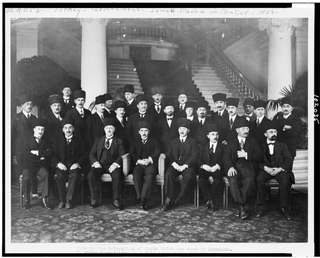
The Conference of Lausanne was a conference held in Lausanne, Switzerland, during 1922 and 1923. Its purpose was the negotiation of a treaty to replace the Treaty of Sèvres, which, under the new government of Mustafa Kemal Atatürk, was no longer recognized by Turkey.

The Kingdom of Iraq under British Administration, or Mandatory Iraq, was created in 1921, following the 1920 Iraqi Revolt against the proposed British Mandate of Mesopotamia, and enacted via the 1922 Anglo-Iraqi Treaty and a 1924 undertaking by the United Kingdom to the League of Nations to fulfil the role as Mandatory Power.

The Hashemite Kingdom of Iraq was a state located in the Middle East from 1932 to 1958.

Sheikh Mahmud Barzanji or Mahmud Hafid Zadeh was a Kurdish leader of a series of Kurdish uprisings against the British Mandate of Iraq. He was sheikh of a Qadiriyah Sufi family of the Barzanji clan from the city of Sulaymaniyah, which is now in Iraqi Kurdistan. He was named King of Kurdistan during several of these uprisings.

The Franco–Turkish War, known as the Cilicia Campaign in France and as the Southern Front of the Turkish War of Independence in Turkey, was a series of conflicts fought between France and the Turkish National Forces from December 1918 to October 1921 in the aftermath of World War I. French interest in the region stemmed from the Sykes-Picot Agreement and was further fueled by the refugee crisis following the Armenian genocide.

The partition of the Ottoman Empire was a geopolitical event that occurred after World War I and the occupation of Constantinople by British, French, and Italian troops in November 1918. The partitioning was planned in several agreements made by the Allied Powers early in the course of World War I, notably the Sykes–Picot Agreement, after the Ottoman Empire had joined Germany to form the Ottoman–German Alliance. The huge conglomeration of territories and peoples that formerly comprised the Ottoman Empire was divided into several new states. The Ottoman Empire had been the leading Islamic state in geopolitical, cultural and ideological terms. The partitioning of the Ottoman Empire after the war led to the domination of the Middle East by Western powers such as Britain and France, and saw the creation of the modern Arab world and the Republic of Turkey. Resistance to the influence of these powers came from the Turkish National Movement but did not become widespread in the other post-Ottoman states until the period of rapid decolonization after World War II.

Kurdish nationalism is a nationalist political movement which asserts that Kurds are a nation and espouses the creation of an independent Kurdistan from Iran, Iraq, Syria, and Turkey.

Iraqi–Turkish relations are foreign relations between Iraq and Turkey. From late 2011 relations between the two countries have undergone strained turbulence. The two countries share historical and cultural heritages.
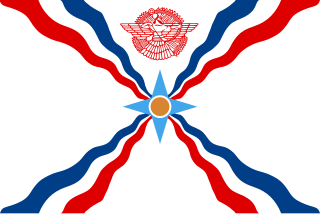
The Assyrian independence movement is a political movement and ethno-nationalist desire of ethnic Assyrians to live in their indigenous Assyrian homeland in northern Mesopotamia under the self-governance of an Assyrian State.

The Vilayet of Aleppo was a first-level administrative division (vilayet) of the Ottoman Empire, centered on the city of Aleppo.

The nationalist movement among the Kurdish people first emerged in the late 19th century with an uprising in 1880 led by Sheik Ubeydullah. Many Kurds worked with other opponents of the Ottoman regime within the Committee of Union and Progress (CUP). A growth in ethnic consciousness at the start of the 20th century was spearheaded by the Society for the Elevation of Kurdistan. Some Kurdish nationalist groups agitated for secession, others for autonomy.
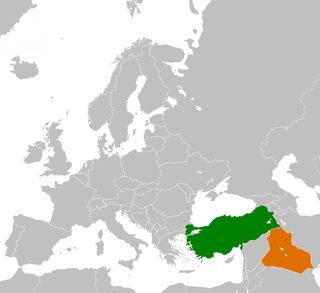
The Iraq–Turkey border is 367 km in length and runs from the tripoint with Syria in the west to the tripoint with Iran in the east.

During World War I, several Kurdish rebellions took place within the Ottoman Empire.

The Iran–Turkey border is 534 kilometres in length, and runs from the tripoint with Azerbaijan in the north to the tripoint with Iraq in the south.

The Assyrian volunteers was an ethnic Assyrian military force during WW1, led mainly by General Agha Petros Elia of Baz and several tribal leaders known as Maliks under the spiritual leadership of the Catholicos-Patriarch Mar Shimun Benyamin allied with the Entente Powers described by the English pastor and author William A. Wigram as Our Smallest Ally.


